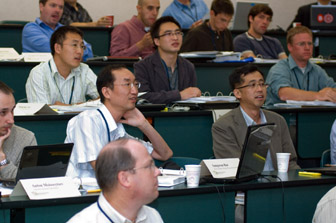Nuclear science students, researchers learn essential computer coding skills at Idaho Falls summer school
July 24, 2009
Aspiring nuclear science researchers, students and technicians from around the world, including 35 students from six foreign countries, are taking classes and meeting with senior mentors in Idaho Falls to learn how to write computer code that could potentially prevent nuclear reactor disasters in the future.
Fifty-three students are attending the two-week “Modeling, Experimentation, Validation (MeV) Summer School” at University Place running through July 31. The school is sponsored by the Idaho National Laboratory, Idaho State University and Argonne National Laboratory. Students have come from Argentina, Sweden, Germany, India, Japan, China and from throughout the United States to attend this school.

MeV refers to the discipline within nuclear science that creates integrated modeling, experimentation and validation computer programs that test functions of nuclear reactors and their components in place of real, physical testing. Many tests are prohibitively expensive to do in the real world. Thus, the importance of properly trained modelers who develop virtual testing cannot be underestimated.
“We have to rely on computer code to complete some of our tests,” said George Imel, chair of nuclear engineering at Idaho State University and one of the primary school organizers. “The trick is how do you verify code predicting something we don’t have real-world data for? We have to produce code that allows us to design safe reactors.”
That “trick,” it appears, is a mix of solid, fundamental science, with a little artistry, and that is where the mentoring of students comes in. The school has attracted many of the top people in their discipline.
“Many of the teachers here are very famous in their field,” said Viet-Anh Phung, a student attending from the Royal Institute of Technology in Stockholm, Sweden. “They are the founding fathers of this discipline and it is a privilege to learn from them.”
Besides offering a rigorous classroom schedule the school is designed to maximize interaction between those just starting their careers in the field with masters and pioneers of their craft. Participants can also earned three graduate credits from Idaho State University.
“We have a good group of well-trained young people who have a high interest in this field," said Nam Dinh, the dean of the school from the INL and another primary school organizer. “At the same time, we have senior people in their field that the students can interact with who can teach them to think outside of the box. The students can gain firsthand knowledge through the mentorship of some of the most distinguished people in their field.”
MeV testing is a hot topic and important one. Organizers had little trouble attracting top teachers and students from around the globe. With a renewed interest in nuclear power worldwide and an expansion of nuclear power plants in some countries the type of coding taught at this school is important for several reasons. For one, many of the pioneers in the field and those with the most knowledge are retiring. This is a way to pass along their knowledge to the next generation of nuclear scientists and engineers. Secondly, old code and models may not be applicable to new technologies so there is a pressing need to create virtual models that can test the new technologies.
“We have to play an active role in training new people to create new code and to contribute to nuclear safety. We need an infusion of young people in this field,” said Victor H. Ransom, one of the school mentors who is currently a professor emeritus at the Purdue University School of Nuclear Engineering. “There are a lot of issues we need to face that are beyond what one university, a group of universities or a national laboratory can do. Wide collaboration, such is what occurring here, is essential in developing reliable code.”
For more information on this summer school visit www.MeVSchool.org.
Categories:
